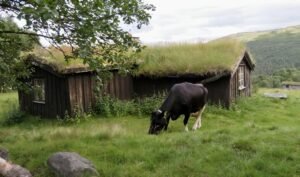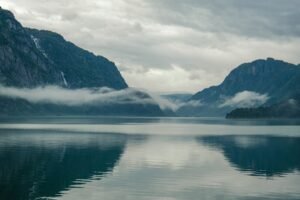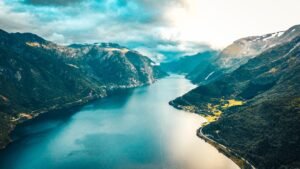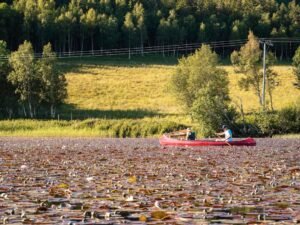

Origins Revealed: Where Are the Viking From?
Have you ever wondered where the Vikings came from? These legendary seafaring warriors have left an indelible mark on history, their tales of conquest and exploration captivating our imagination. But the question remains: where are the Vikings from? Delve into the mystery and join us on a journey to uncover the origins of these fierce Norsemen.
Table of Contents
ToggleKey Takeaways:
- Explore the geographical roots of the Viking people.
- Discover the ancient history of the Norsemen, tracing their origins back to the Scandinavian region.
- Unravel the migration patterns of the Vikings and their adventures beyond their homelands.
- Uncover archaeological discoveries and historical evidence to paint a picture of the Viking homelands.
- Reflect on the rich history of the Vikings as formidable Scandinavian warriors.
The Ancient Roots of the Norsemen
Explore the rich viking history and uncover the origins of the Norsemen, tracing their roots back to the Scandinavian region. These fierce warriors and seafarers left an indelible mark on history, but their story begins long before their tales of conquest and exploration.
In the ancient lands of Scandinavia, a collection of tribes and early cultures laid the groundwork for the fearsome Viking warriors that would emerge centuries later. The Norsemen, as they were also known, inhabited the region during the period we now refer to as the Viking Age, which spanned roughly from the 8th to the 11th century.
The Norsemen were not a homogenous group, but rather a collection of various tribes and clans with their own unique customs and traditions. They hailed from what is now modern-day Norway, Denmark, and Sweden. Each region had its own distinct dialect and cultural practices, although they all shared a common ancestral heritage.
It is believed that the Norsemen’s ancestors can be traced back to the Germanic peoples who inhabited the northern parts of Europe during the early Iron Age. Over time, these Germanic tribes migrated to Scandinavia, where they gradually formed distinct regional identities that would later coalesce into the mighty Viking civilization.
“The Norsemen were not a homogenous group, but rather a collection of various tribes and clans with their own unique customs and traditions.”
During this period, Scandinavian society was deeply rooted in agriculture, fishing, and trade. The Norsemen relied on fertile lands, navigable rivers, and the vast ocean that surrounded them. These natural resources provided sustenance and opportunities for exploration and expansion.
The Nordic people were skilled seafarers, using their sturdy longships to navigate the treacherous waters of the North Atlantic and explore distant lands. Their ships, with their shallow drafts and flexible rudders, allowed them to navigate shallow rivers and raid coastal settlements with ease.
As the Norsemen honed their seafaring skills and established trade networks, their influence spread beyond Scandinavia. They ventured to far-off lands such as Iceland, Greenland, and even as far as North America, long before the voyages of other European explorers.
The Viking Age marked a tumultuous and transformative era in history. The Norsemen’s expeditions, raids, and settlements significantly shaped Europe and beyond. They were not just fearsome warriors; they were also skilled craftsmen, poets, traders, and explorers. The legacy of the Norsemen’s conquests, achievements, and cultural contributions can still be felt today.
Viking Cultural Achievements
The Norsemen were not only known for their martial prowess but also for their artistic and cultural achievements. They were skilled metalworkers, creating intricate jewelry and ornate weaponry. Their shipbuilding techniques revolutionized naval architecture, allowing for faster and more agile vessels.
Viking mythology and poetry also thrived during this period, with sagas and epics recounting the heroism and valor of legendary figures like Thor, Odin, and Ragnar Lothbrok. The Norsemen believed in a pantheon of gods and goddesses, which their art and literature often depicted.
Additionally, the Viking Age saw the establishment of the world’s first parliamentary system, known as the Alþingi, in the Norse colony of Iceland. This institution laid the groundwork for democratic governance and lawmaking and influenced future political systems.
Viking Inventions and Contributions
| Invention/Contribution | Description |
|---|---|
| Longships | Sleek and flexible vessels used for trade, exploration, and raids. |
| Runestones | Carved stones with inscriptions, often used to commemorate the achievements and life of individuals. |
| Alþingi | The world’s first parliamentary system, established in the Norse colony of Iceland. |
| Artistic Metalwork | Elaborate jewelry, weaponry, and decorative objects showcasing superb craftsmanship. |
| Sagas and Epics | Oral and written narratives detailing the adventures and heroic feats of legendary figures in Norse mythology. |
The Viking Age may have come to an end, but its impact on history and culture lingers. The ancient roots of the Norsemen lay in the Scandinavian region, where early settlements and vibrant cultures paved the way for the fearsome Viking warriors and their enduring legacy.
Viking Migration Patterns
The Vikings were a seafaring people known for their daring voyages and exploration of new lands. Their migration patterns played a crucial role in shaping the history of the Viking Age. Let’s delve into the fascinating journeys undertaken by these Norse adventurers.
Leaving the Homeland
The Vikings originated from various Scandinavian regions, including present-day Norway, Denmark, and Sweden. As populations grew and resources became scarce, many Vikings sought new opportunities beyond their homelands. This led to the establishment of numerous Viking settlements in different parts of Europe.
Adventures and Conquests
The Vikings embarked on epic journeys, venturing across vast distances to explore and conquer new territories. Their expert shipbuilding skills allowed them to navigate treacherous waters, reaching as far as the British Isles, Iceland, Greenland, and even North America long before Christopher Columbus’s arrival.
“The Vikings were fearless explorers, always pushing the boundaries of their known world. Their migration patterns were driven by a desire for wealth, fame, and new opportunities.” – Norse Saga
These Viking expeditions were not just limited to raids and pillaging; they also involved trade, colonization, and the establishment of enduring settlements. Viking traders established key trading routes, connecting Scandinavia with the rest of Europe, contributing to the diffusion of goods and ideas.
Legacy and Impact
The Viking migration patterns left a lasting impact on the regions they encountered. In some cases, they assimilated with local populations, such as in Normandy, where Vikings eventually became the ruling class. Their presence in these regions led to cultural exchanges, influencing language, art, and governance.
Their migration patterns also shaped the political landscape of Europe, as Viking leaders established powerful kingdoms and played a significant role in regional politics. Historians believe that the Viking migrations helped break down feudal structures and contributed to the rise of nation-states.
| Viking Settlements | Migrated To |
|---|---|
| Normandy | France |
| Danelaw | England |
| Kievan Rus | Russia |
| Islay | Scotland |
| Vinland | North America |
The Viking migration patterns exemplify the boldness and resilience of these Norse seafarers. Their explorations paved the way for future discoveries and their rich cultural heritage continues to captivate us today.
Unraveling the Mystery of Viking Homelands
Join us as we embark on a fascinating journey to unravel the mystery of the ancient Viking homelands. Through a careful examination of archaeological discoveries and historical evidence, we aim to shed light on the exact locations that served as the cradle for the Viking civilization.
The Vikings, known for their seafaring prowess and legendary conquests, originated from a distinct region that formed their ancestral homeland. Through their unparalleled exploration and colonization efforts, they left an indelible mark on the lands they encountered. But where exactly did these intrepid warriors call home?
Archaeologists and historians have long grappled with this question, piecing together fragments of evidence to reconstruct the ancient Viking homelands. Their efforts have resulted in a deeper understanding of the geographical roots of the Viking civilization.
Ancient Norse sagas, written accounts, and studies of Viking ship burial sites have provided valuable insights into the regions that played a crucial role in Viking history. These sources, along with other archaeological finds, have enabled researchers to map out the approximate locations of the Viking homelands.
The primary ancient Viking homeland can be traced to the Scandinavian region, encompassing what is now modern-day Norway, Sweden, and Denmark. It was from these lands that the Vikings set sail, venturing forth on their epic voyages of exploration and conquest.
However, it is important to note that the Viking homelands were not confined to a single place. There were various sub-regions within the Scandinavian countries that contributed to the formation of Viking society.
Examples of these sub-regions include Hordaland in Norway, Uppland in Sweden, and Jutland in Denmark.
According to Norse sagas, the Kattegat and Skagerrak straits, which connect the North Sea and the Baltic Sea, served as important maritime highways for the Vikings. The proximity of these waterways to the Scandinavian region further facilitated their seafaring activities and exploration of distant lands.
As we delve deeper into the mystery of the Viking homelands, it becomes evident that the origins of this mighty civilization lie within the ancient lands of Scandinavia. The rich tapestry of historical evidence and archaeological discoveries continues to provide valuable insights into the Scandinavian warriors who forever changed the course of history.
| Important Viking Homelands | Region |
|---|---|
| Hordaland | Norway |
| Uppland | Sweden |
| Jutland | Denmark |
Conclusion
Throughout this article, we have delved into the captivating history of the Vikings and their legacy as formidable Scandinavian warriors. From their ancient roots in the Scandinavian region to their far-reaching migration patterns, the Vikings have left an indelible mark on history.
We have uncovered the origins of the Vikings, shedding light on their ancestral homelands and painting a vivid picture of their early settlements and cultures. This insight into their beginnings has provided a deeper understanding of their fierce warrior spirit and thirst for adventure.
The rich tapestry of Viking history continues to fascinate and inspire us today. Their exploits and conquests have become the stuff of legend, earning them a well-deserved reputation as unparalleled warriors. From their raids across Europe to their exploration of new lands, the Vikings were a force to be reckoned with.
As we conclude this exploration into the Viking saga, we are reminded of their lasting impact on the world. Their legacy lives on not only in history books but also in cultural heritage, language, and the enduring fascination with their way of life. The Viking history and their legacy as Scandinavian warriors will continue to captivate and inspire generations to come.
FAQ
Where are the Vikings from?
What is the origin of Vikings?
What is the history of the Vikings?
What were the Viking migration patterns?
Where were the Viking settlements?
What is the ancient Viking homeland?
If you want to learn Norwegian, you can register for classes here. We look forward to hearing from you and helping you become fluent in Norwegian.





